Feature Restoration 1946 Willys Jeep CJ-2A
It’s Been 75 Years Since the First Jeep Went Into Mass Production and the Early Ones Still Have a Devoted Following.
Before Jeeps morphed from do-anything working vehicles into ones with a broader base, difficult conditions and everyday abuse often ensured a limited life expectancy; so finding a restorable early example can be a challenge. That’s something Kevin Ryczak understood long before he owned the 1946 Jeep CJ2A featured here.
“I had always dreamed of rebuilding a flat-fender Jeep,” he explained. “My first choice was military. But they’re very hard to find and they’re very expensive compared to the CJ. I’d actively been looking for one for a while. It just seemed that if people had them, they didn’t want to sell them and the ones that were for sale? There was nothing left of them.”
With WWII, the Army Needed a Light Reconnaissance Vehicle…
The “flat-fender” nickname applies to Jeeps through the CJ-3B built from 1953 through 1965 for the American market. Their flat fenders can be traced back to some of their earliest ancestors among the military models of which Ryczak spoke.
All Jeeps, though, can be traced to one vehicle, American Bantam’s initial BRC-60. Bantam was the bankrupt American Austin’s reincarnation and built what today would be called microcars. Neither company thrived, given that few Americans then wanted miniature cars, but the experience enabled Bantam to respond to the U.S. Army’s interest in a small four-wheel-drive vehicle by delivering a prototype—the Bantam Reconnaissance Car—on September 21, 1940.
The bad news was that the Army had given access to Bantam’s work to Willys and Ford, which were now in on the project. Willys’ Quad prototype was delivered on November 13, Ford’s Pygmy arrived 10 days later and unsurprisingly, both were similar to the Bantam. All used flathead fours and three-speed transmissions while the later arrivals were slightly longer and the key differences were primarily in horsepower and weight.
The Army initially ordered 1500 units from each of the three and Willys delivered 1553 vehicles, now called the MA, while Ford produced about 4500 of its GPs. Bantam produced about 2600 BRC-40s, the last motor vehicles it would build before being squeezed out due to its production limitations while Willys’ updated MB version became the standard with additional production by Ford as its GPW.
As the designs evolved toward military standardization, grilles, hoods and headlights changed and the Bantam’s round fenders were dropped in favor of flat fenders. When regular production began in 1941—75 years ago—the vehicle was finally in the form that would be recognized worldwide as “the army jeep” and is undeniably the vehicle to which all military and civilian Jeeps right to today’s Wrangler owe their very existence. (With that in mind, note Jeep’s tribute to its ancestry on page 23.)
Anyone with the barest knowledge of World War II is aware of the jeep’s contribution to the Allies’ victory, but it’s hard to imagine that in 1941 anyone could have foreseen the magnitude of that contribution, the odd roles jeeps were called on to fill and the appreciation they earned from those who depended upon them. Willys built about 335,000 examples by the war’s end and Ford produced more than 280,000. But Willys also was planning for the civilian marketplace even before peace arrived and began advertising the importance of Jeeps in the postwar world.
One Willys ad pictured a Jeep in a farm setting above copy purporting to be a farmer’s observation that “yes, we had a real, genuine ‘Jeep’ at our farm for a few days. It was the biggest event that ever occurred in our section, in my opinion.” The ad closed with his statement that “I certainly will try to have a ‘Jeep’ if they are available after the war. Willys has done a great job.”
Simultaneously, Willys was building its case to trademark “Jeep” with the uppercase “J.” It boasted in other ads that “to millions of people all over the world, ‘Jeep’ means ‘Willys.’”
Basking In Its Wartime Accomplishments
The “Jeep” name in the immediate postwar period was fresh in minds nearly everywhere and allowing a civilian model to shine in the military version’s reflected glory was shrewd. A 1946 ad flatly stated that the Jeep was “warproved for stamina and performance…a symbol of America’s victorious forces in all corners of the world.”
The “Jeep” name in the immediate postwar period was fresh in minds nearly everywhere and allowing a civilian model to shine in the military version’s reflected glory was shrewd. A 1946 ad flatly stated that the Jeep was “warproved for stamina and performance…a symbol of America’s victorious forces in all corners of the world.”
Furthermore, the modifications that had helped the military Willys MB to become the civilian Willys Jeep CJ-2A did nothing to weaken the truck when it went on sale to the public in mid-1945.
Mechanically, significant changes included an upgraded transmission, a gear ratio better suited to hauling, a strengthened frame and a shrouded radiator, while easily noticed improvements to the body barely changed the Jeep’s look. Headlights were larger and slightly ahead of the grille rather than behind it, the grille itself carried seven slots instead of the previous nine, a tailgate was added and seats were less uncomfortable. Beyond the improved seats, the CJ-2A further differed from the MB in its selection of options ranging from front and rear power-takeoffs to a compressor, an arc welder and a heater. Aftermarket suppliers expanded the accessories list to include items such as snow plows which Ryczak recalled seeing in his younger days.
Jeep Of All Trades
In addition to clearing roads in the wintertime, Jeeps earned a civilian reputation for working just about everywhere in all conditions. Advertising showed them hard at work as a package-laden Jeep in the city to trailer-towing along a small-town main street to farmland use and in what came to be known as “runabout” duty.
The runabout category was a catchall, as a Florida Jeep’s owner could explore hard-to-reach vacation spots and a Colorado sportsman could get to sites inaccessible to cars. But an Argentine scene pushed the bounds of believability as it pictured a standing gaucho steering a Jeep with one hand and brandishing a whip in the other to herd cattle on the pampas.
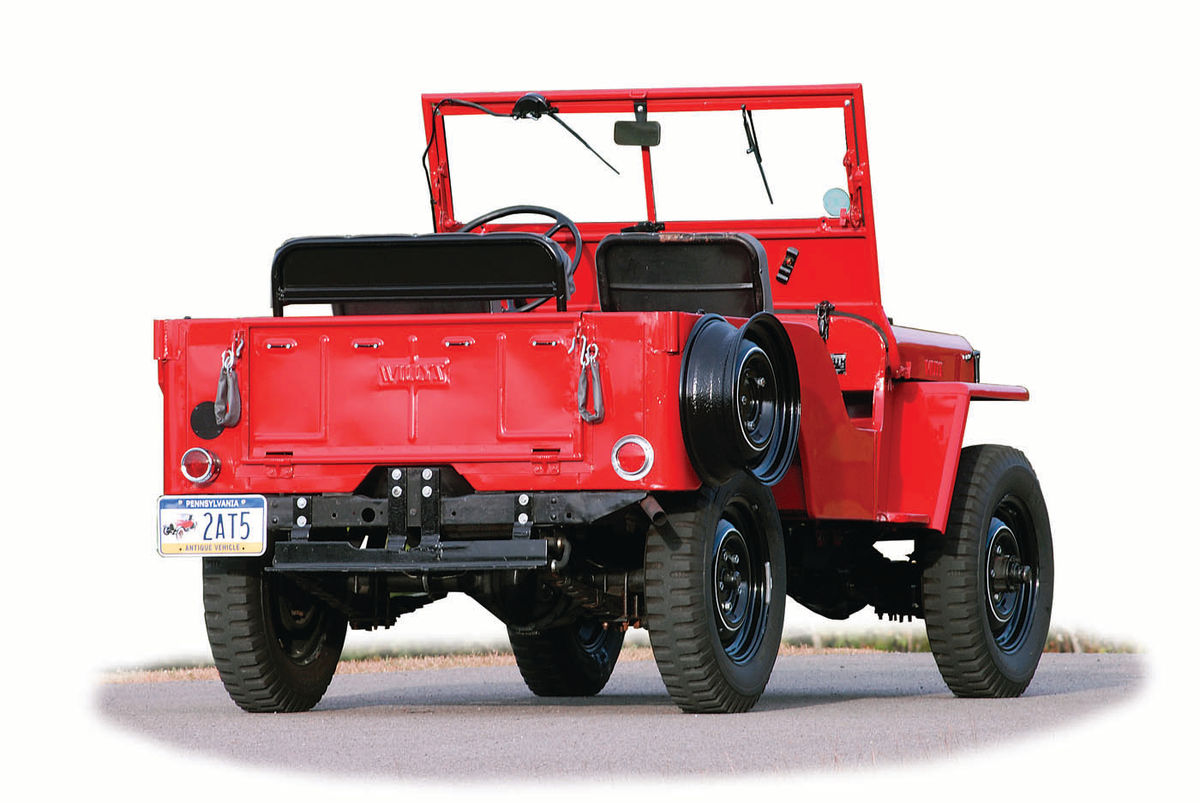
The Frame Was Surprisingly Good
Ryczak’s Jeep didn’t chase cows in South America before he found it in Connecticut 13 years ago. It had plowed snow, however, and he said that plowing stresses the frame horns beyond their design limits.
“The frames weren’t made for that,” he said, “and they would bend those horns and the frames, so typically, that was a really bad thing. This (owner), for whatever reason, reinforced it with wood and he had parts welded and attached to the front to reinforce it. So it had a snowplow on it, but it was really reinforced and by the leaf springs, he had these big coil springs that he had put in between the frame and the springs because of the weight of the plow.”
Rust is the other big problem on the frames, although his was solid and required only stripping, cleaning and a careful coating of POR-15. It was solid enough, in fact, that he sold the frame from the parts Jeep that came with the featured 1946 CJ-2A. The parts Jeep was rough, but important.
“The ’46 had its engine in it,” Ryczak said, “but it wasn’t running. The ’48 parts Jeep was running, but the body was totally disintegrated. It was so bad that the metal pedals for the brake and the clutch looked like waffleboards.”
Ryczak said the feature Jeep’s engine was partly disassembled when he bought it and he decided to have it rebuilt, so he temporarily replaced it with the running engine to enable the 1946 to move under its own power. He then opened the differentials, transmission and transfer case, cleaned them and installed all new seals and gaskets since there was no sign of serious wear even after about 60,000 miles. The springs were also disassembled for inspection, then coated with POR-15 and given new bushings during reassembly. Ryczak replaced the starter, rebuilt the carburetor and replaced the steering box’s gaskets and worn components as needed.
The Jeep was mostly complete, with small parts like the gauges and dashboard light intact, and even one extra component was still in place.
“There was a heater,” Ryczak said. “They didn’t come from the factory. It was a dealer option and I still have it. It’s just a little heater core with a blower in it. It mounts up under on the driver’s side and it blows down onto your feet. I don’t even know that you could feel it, to be truthful.”
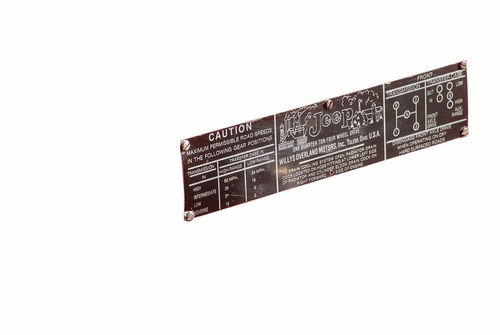
A heater’s nice, but seats are nicer and those in the feature Jeep needed to be rebuilt.
“At the time,” Ryczak recalled, “they only offered foam that you could put under the seat covers. It was a very nice kit, but now they offer the bedspringtype originals. They look like bedsprings and they put horsehair over the top of them and then the cover over it.”
He also replaced the wiring harness with a reproduction, one of the restoration’s more straightforward phases.
“There’s one circuit breaker on the headlight switch,” he said. “That’s the only one…and there are no fuses.
“It’s very simple. You’ve got the headlights, taillights, the gauges— you’ve only got the one light, so you don’t have any lights in the gauges— the gas tank, the horn, the regulator and one taillight, the stoplight-taillight. You really don’t have that much.”
The Body Was In Very Bad Shape…
Eventually, the engine swap was reversed and today the parts Jeep’s engine is in storage with its transmission, transfer case, one of its differentials and some miscellaneous parts such as the air cleaner.
The parts body was so poor that most of it was scrapped, but Ryczak saved the original grille despite its rough condition.
Unfortunately, most of the feature Jeep’s body wasn’t much better.
“The front, the grille, the fenders and the hood were immaculate for that year,” Ryczak said, “because typically, they have the hat channels that run up through the fenders. The only blemish on the fenders was that somebody had drilled a hole and mounted a turn signal on top. The only thing that was wrong with the one on the driver’s side was that there was a slight crack down at the bottom of it. Other than that, you had the original wood in the channels.”
He sold the fenders to another restorer looking for a set of originals, but the rest of the body was less fortunate.
“The cowl was in really good shape,” Ryczak continued, “but beyond that? There was no toolbox, no flooring and the fenders in the back, where the spare tire is, those channels were all rotted out. There was a big hole where the spare tire used to be, the tailgate was rusted at the bottom pretty badly.
“The (previous owner) also took a plate and welded it on the back. The spare tire fell off the side, so what he did was take the mount and put a plate on the inside and then drill four holes and then mount the spare tire on the back of the tailgate. He ruined my tailgate. He also had a plate welded across the bottom, a channel. He was probably towing things.”
…But There Are Kits to Remedy That
While it’s true that any vehicle can be restored, doing so in some cases can be likened to madness and the body on Ryczak’s CJ-2A might have placed it in that area. The solution, though, points to one of the great pluses of a Jeep as a restoration project.
“I bought a brand-new body kit,” Ryczak said. “Everything, the tub, windshield, fenders, hood, grille, tailgate, complete.”
The only exception to “complete” is the grille, which is the original since a new replacement was unavailable at the time. The body differs from the original in that its toolbox lacks a “Jeep” script and that, too, was then unavailable, but the lack of a spare tire has a different story behind it as Ryczak said early examples were often delivered with only the spare rim.
“If you want a good example of that,” he said, “toward the beginning of the original ‘Miracle on 34th Street’ movie, the parade floats are pulled with CJ2As and none of them have tires on the spares. All they have is the rim on them.
“I do have a tire and I am going to mount the tire on there. A lot of people make comments on that, but I say ‘hey, 1946, the year after the war, no rubber. That’s just the way it was.’”
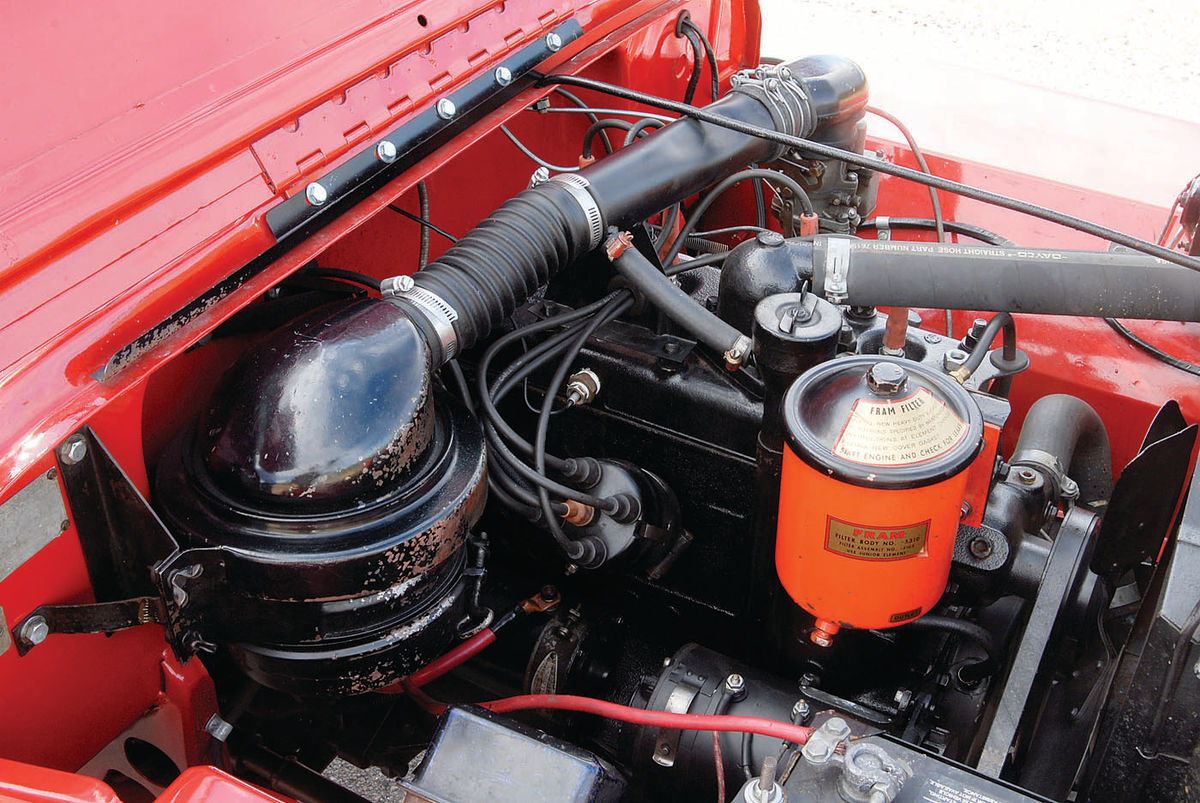
The spare tire’s weight can overload the panel, of course, and Ryczak said that while some owners add support, damage is almost inevitable. It’s the price of squeezing extra cargo space out of such a small vehicle and the spare isn’t the only thing riding outside of the area typically used to hold loads.
“There are two pockets welded on the side right behind the gas tank and on the back quarter,” he explained. “What you use that for is to stow the bows of the top. You would tie them in so that they wouldn’t bounce out while you were driving down the road.”
The canvas cab, he continued, would then be folded and tied down on the fenders, but the frames for the doors would be folded and stowed outside of the cargo area below the windshield. The door canvas, like that of the cab, would be folded and tied down; part of a process that Ryczak agreed is complicated.
“It was a pain the neck,” he said. “It wasn’t like the Velcro or the snaps that we have today. They used those straps and you had to run them through the footman loops and then take everything apart and put it back together. It was canvas, so it wasn’t like the new tops. It’s not that easy.”
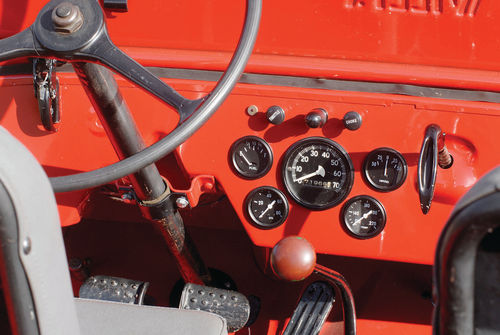
Although the doors can be removed and reattached quickly by sliding them in or out of small brackets, taking the top off and reinstalling it was a decision few owners likely made spontaneously when CJ-2As were everyday working vehicles. And there’s still more than what’s already been described.
“In the floor,” Ryczak said, “which a lot of people don’t notice, are three footman loops right behind the seats and they’re for the half-cab. If you had a half-cab, you would just strap it in. Otherwise, they’re just there. There’s an indent where they kind of sit down in the floor.
“This one didn’t have it, but across the top of the windshield there are twist fasteners to hold the front of the top.”
It’s Certainly Not Like a Modern SUV
Those who know even a little about Jeeps know that the windshields fold, although they might not be familiar with all of the details. The CJ-2A’s entire windshield assembly drops flat to ride on hood-mounted bumpers, but the actual windshield—the glass with its small frame—can open to a range of angles while the assembly is in its normal erect position. And then there’s the routing of the vacuum line to power the driver’s wiper for that folding windshield.
“It hooks up to the manifold,” Ryczak said, “and it runs through the side of the body. There’s a grommet there and it runs in along the windshield, it has little clips and it goes into the vacuum motor. The passenger side is handoperated, labor-intensive.”
Out on the road, the CJ-2A’s vacuum wiper would be a small part of an eye-opening experience for a driver unaccustomed to older vehicles and whose manual-transmission experience is limited to those of the past decade or two.
“It’s only got three gears and first gear is very short,” Ryczak said. “I think a lot of people just have a tendency to stall it because if they dump the clutch, it kind of lurches a little bit and dies.”
And there’s more to discourage all but the most dedicated Jeep fans.
“It’s hard to drive,” Ryczak stated, “it’s all over the road, the seats aren’t really comfortable, it’s kind of cramped, so you’re fighting it all the way plus there’s no top on it and you get the wind beating you up.”
So why would anyone endure that?
“I’ll put the windshield out, I’ll put the windshield down, I’ll modify it in different ways,” Ryczak said. “I love to take my grandkids in it and my grandkids love to ride in it. We do 25 miles an hour down Main Street and they think we’re going 100 because we’re out in the open. Yeah, I just enjoy it. I’d drive it all the time, if I could.”
They Generally Aren’t An Easy Project
Only the most dedicated curmudgeon would deny that the early Jeep’s fun factor cancels out many of its restoration difficulties and on-the-road quirks. But even those who can’t resist its appeal will come up against a major roadblock when they begin looking for one that’s realistically restorable.
Ryczak said that he’s seen a few others that had potential and the feature Jeep isn’t the first one he’s owned. The list includes 1957 and 1968 CJ-5s and a 1976 CJ-7 and he said he’s rarely been without one since the 1970s. It’s a family thing; his brother, Frank, at T&R Service in Mayfield, Pennsylvania, has experience in racing, repairing and restoring Jeeps going back just as far.
“I had a guy call me up and he had one of these,” Ryczak said. “He had bought it and dragged it out of a field. I went up to look at it and it was toast. The guy was saying ‘I’ll bring it down. I’ll deliver it to your garage’ and I said ‘it’s not worth anything.’”
A rusted body is to be expected, he said, but if the chassis is in good condition, a tub might be the answer. He explained that installing a tub involves more than removing the original and dropping the new one in place.
“You still have to drill the holes out for your pedals and stuff,” he said, “but the (holes for the) gauges are all out, the emergency brake handle is put in there. They’re pretty accurate, but they still require some work. Before you paint it, you want to make sure that everything fits. We had to modify ours. I wanted the gusset that had the serial number for my Jeep, so we actually cut the one off that was on the (new) body and we welded this one in there.
“We had to assemble the whole Jeep and then once it was done and we felt everything was fitted well, we ripped everything apart to get it painted.”
Some of the other likely needs are less immediately visible and slightly more manageable, as he predicted that new gaskets and seals will be necessary to address the leaks for which early Jeeps are known. A restorable example’s brake system is all but certain to need replacement because of both age and the life the Jeep is likely to have led.
Like any other car or truck of its age, the time is approaching when any restorable example will prove to be a major project. But then hope never really goes away.
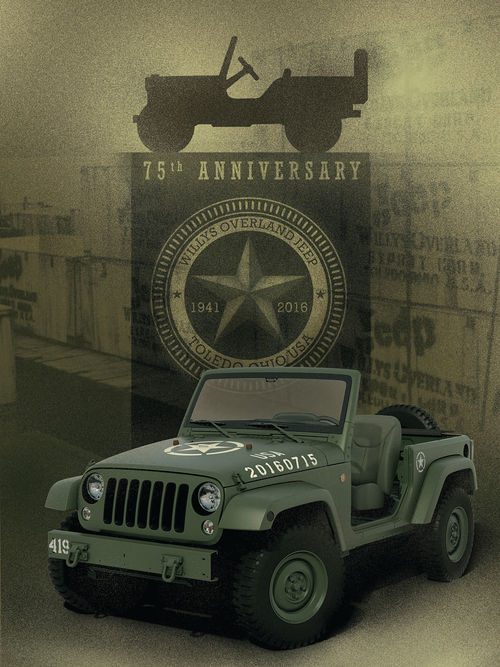
“Everybody’s dream,” Ryczak said, “is to find the barn that has one sitting in it. I keep looking in every barn I drive by, but the chances are very slim.”
Slim is enough because, as he said, it’s everybody’s dream. He sees that at car shows, where there are always those who walk around it and walk around it and then walk around it again. That usually results in his offer for a closer look.
“A lot of guys, when you go to a car show, nobody can touch their cars,” Ryczak observed. “Me? I’m like ‘hey, put the kids up there; take a picture’ because that’s what a Jeep is all about.”
















